Transcription of ENGLISH MyoSure Rod Lens Hysteroscope …
1 1 ENGLISHD evice DescriptionThe MyoSure Rod lens Hysteroscope is intended for use in visualizing the uterine cavity and performing operative hysteroscopy procedures including use with the MyoSure Tissue Removal Device. The MyoSure Rod lens Hysteroscope system includes a removable outflow channel and the Hysteroscope . The removable outflow channel is intended to be used to provide a fluid outflow lumen when the Hysteroscope is being used in a diagnostic mode. The removable outflow channel includes a sealed entry port to permit the introduction of instrumentation.
2 The reusable rod lens Hysteroscope utilizes rod lenses for visualization and fibers for illumination. The Hysteroscope includes a working channel designed to accommodate the respective MyoSure Tissue Removal Device. (See Table 1.) The Operative Hysteroscopy System can be combined with a hysteroscopic fluid management system to provide continuous flow hysteroscopy capability. The Hysteroscope is normally coupled to a camera and video display unit for for UseThe MyoSure Rod lens Hysteroscope is used to provide viewing of the cervical canal and the uterine cavity for the purpose of performing diagnostic and surgical Hysteroscopy Abnormal uterine bleeding Infertility and pregnancy wastage Evaluation of abnormal hysterosalpingogram Intrauterine foreign body Amenorrhea Pelvic PainMyoSure Rod lens HysteroscopeInstructions for FEDERAL LAW RESTRICTS THIS DEVICE TO SALE BY OR ON THE ORDER OF A
3 PHYSICIANRead these instructions completely prior to using the MyoSure Rod lens instructions describe two MyoSure Rod lens Hysteroscopes: Catalogue numberProductHysteroscope working channel diameterOutflow channel part numberCompatible MyoSure Tissue Removal Devices 40-250 MyoSure Rod lens Hysteroscope3 mm 40-201 MyoSure Tissue Removal Device 10-401 MyoSure LITE Tissue Removal Device 30-401 LITE 50-250 XLMyoSure XL Rod lens Hysteroscope4 mm 50-201 XLMyoSure Tissue Removal Device 10-401 MyoSure LITE Tissue Removal Device 30-401 LITEMyoSure XL Tissue Removal Device 50-401 XLTABLE 1.
4 23 ENGLISHO perative Hysteroscopy Directed biopsy Removal of submucous fibroids and large polyps Submucous Myomectomy (see Contraindications) Transection of intrauterine adhesions Transection of intrauterine septaContraindications Acute pelvic inflammatory diseaseHysteroscopy may also be contraindicated by the following conditions, depending on their severity or extent: Inability to distend uterus Cervical stenosis Cervical/vaginal infection Uterine bleeding or menses Known pregnancy Invasive carcinoma of the cervix Recent uterine perforation Medical contraindication or intolerance to anesthesiaContraindications to Hysteroscopic MyomectomyHysteroscopic myomectomy should not be undertaken without adequate training, preceptorship, and clinical experience.
5 The following are clinical conditions that can significantly complicate hysteroscopic myomectomy: Severe anemia Inability to circumnavigate a myoma due to myoma size ( , predominantly intramural myomas with small submucous components).Warnings For use only by physicians trained in hysteroscopy Suspicion of pregnancy should suggest a pregnancy test before the performance of diagnostic hysteroscopy. The MyoSure Hysteroscope is only to be used in conjunction with accessories that comply with the following safety standards: National/Regional versions of IEC 60601-1, the general safety requirements for medical devices; and, as applicable, IEC 60601-2-18, particular safety requirements for endoscope equipment and accessories; and IEC 60601-2-2, particular safety requirements for High Frequency (HF) surgical equipment and accessories.
6 Before using any accessory, be sure to follow the instructions provided with the accessory, including in the case of a HF electrode, the maximum recurring peak voltage rating. When using HF surgical equipment, keep the working part of the active electrode in the field of view to avoid accidental burns. The Hysteroscope and outflow channel are shipped non-sterile. They must be thoroughly cleaned and sterilized before use. If scope light post adapters have been used, they need to be disassembled, cleaned, and sterilized before every subsequent use.
7 Uterine perforation can result in possible injury to bowel, bladder, major blood vessels, and ureter. High energy radiated light emitted from illuminating fiber at the distal end of the scope may give rise to temperatures exceeding 106 F/41 C (within 8 mm in front of the scope). Do not leave tip of scope in direct contact with the patient tissue or combustible materials, as burns may result. Lower the light source output when working in close proximity to the object. The Hysteroscope light post and adapter may exceed temperatures of 41 C.
8 Hysteroscopes should not be placed on the patient or on combustible materials, as burns may result. To prevent potential safety hazard to the patient caused by accidental loss of function of the device ( , front end damage by surgical instruments) it is recommend to have an additional sterile stand-by device during surgical procedures. When scopes are used with laser equipment, appropriate filtering spectacles must be worn by the operating team. In some cases, a specific filter must be put between the scope and camera head to prevent camera damage by high-power laser radiation.
9 Contact your laser supplier for details. To prevent scope damage by high-power laser radiation, always ensure that the laser delivery fiber is seen through the scope and not directed at the scope before energizing the Continuous Flow Hysteroscopy: If liquid distension medium is used, strict fluid intake and output surveillance should be maintained. Intrauterine instillation exceeding 1 liter should be followed with care due to the possibility of fluid overload. Potential Complications of Continuous Flow Hysteroscopy: Hyponatremia Hypothermia Uterine perforation resulting in possible injury to adjacent anatomy Pulmonary edema Cerebral edemaPrecautions Vaginal ultrasonography before hysteroscopy may identify clinical conditions that will alter patient management.
10 Intrauterine distension can usually be accomplished with pressures in the range of 35 75 mm Hg. Unless the systemic blood pressure is excessive, it is seldom necessary to use pressures greater than 75 80 mm Hg. Do not use the seals if the sterile package is open or appears compromised. Do not use the device if damage is observed. Avoid exposing the scope to sudden temperature changes. Do not immerse hot scopes into cold water or liquid. Any mechanical manipulation of the eyepiece may result in seal breakage, therefore do not attempt to remove the eyepiece.






